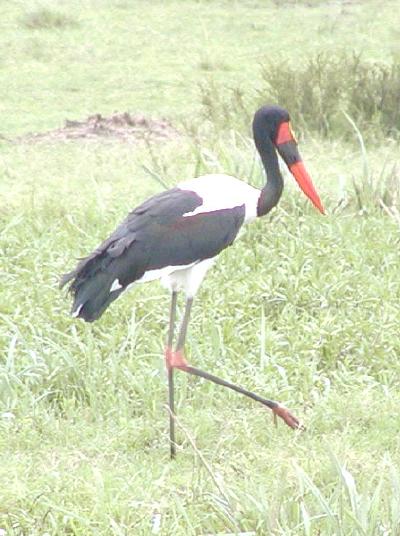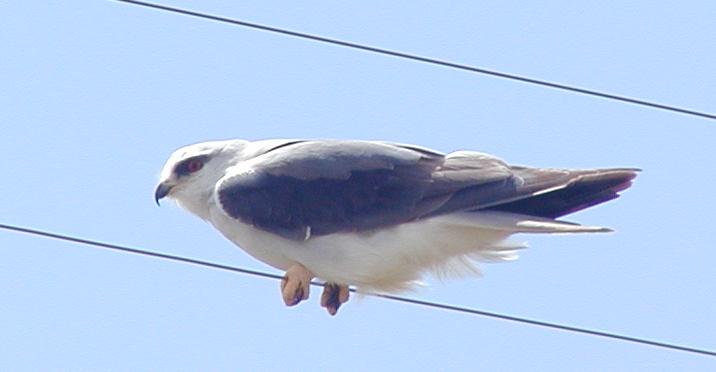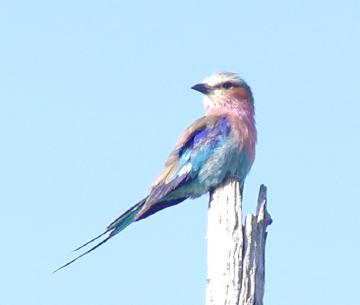PEACHFRONT SPEAKS
The Online Mineral Museum IS BACK!!!.
The Amazing Bolivian Parrot and Rare Macaw EscapadeEagle Overload: More Eagles, More Cats, the South Africa Edition
MY KENYA DIARY: IN QUEST OF EAGLES
MADAGASCAR DIARY: SERPENT-EAGLES, GOSHAWKS, AND MORE
A Very Partial Index to the Entries
A for the time being not even remotely complete guide to all 4,300+ plus entries
BIRDS***BIRDING***WILDLIFE GARDENING
SF/BOOKWORM***NUCLEAR/SPACE
A Google-Plus Verified Author
|
2004-02-11 - 9:35 a.m. This is Part Four of my Kenya diary based on my January Raptours trip headed by Bill Clark, author of A Field Guide to the Raptors of Europe, the Middle East, and North Africa as well as several other leading guides. Part One can be found right here. Part Two can be found right here. Part Three can be found right here. And here's the bird list and the animal list.
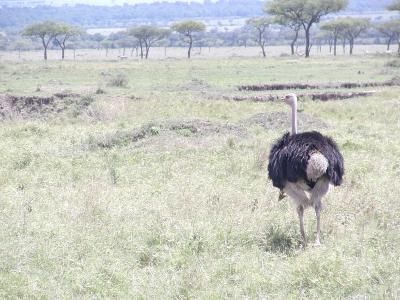 � 2004 by Elaine Radford, all rights reserved A splendid black and blood-red bird, the Black-Headed Gonolek, serenaded the morning. We checked the roof and grounds for a few last minute birds, and I got the Woodland Kingfisher that I'd missed yesterday when I was hiding from the heat of day. The roads seemed to be lined with birds. Not all that far into our trip, while checking a spot where we'd seen snake eagles on our original journey, we came to a screeching halt to admire a fine specimen of an extremely rare adult Beaudouin's Snake-Eagle. Bill commented that there are only about five records of the species in Kenya, so he was careful to get photographs after we'd all had a chance to fully enjoy the posing bird in the scope. If your only experience of the so-called third world is Mexico or Central America, where paying a toll gets you access to a broad modern highway, then you're going to have the wrong idea about roads in Kenya. We paid a toll to access a "privately maintained road" which gave no evidence of having ever been maintained. If not for the guards at each end, I would have assumed that it was a dry stream bed. An extremely rocky dry stream bed. The original van couldn't have progressed a mile, so it was a good thing we'd switched to the Land Rover. And this, my friends, is the road into the Kichwa Temba camp:
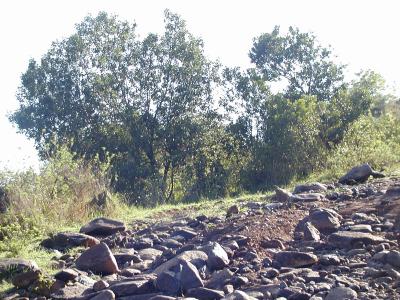 � 2004 by Elaine Radford, all rights reserved It was a fine day for raptors, as the day's list reveals:
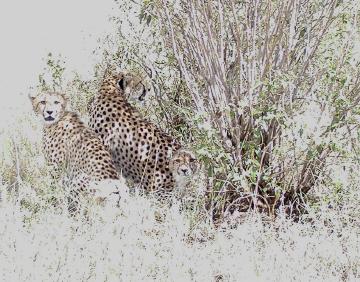 � 2004 by Elaine Radford, all rights reserved
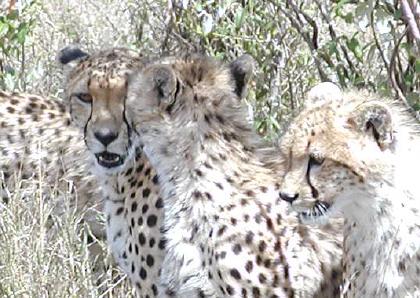 � 2004 by Elaine Radford, all rights reserved
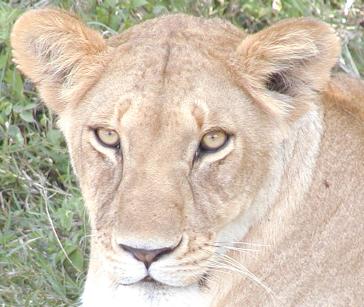 � 2004 by Elaine Radford, all rights reserved The rest of us were just a tad weirded out by the live band by the campfire performing the most lugubrious folk songs of the 1960s and early 1970s. Now I like a good folk song as much as anyone, and no one is a bigger Dylan fan, but it can't all be Blowin' in the Wind and Leavin' On a Jet Plane and (my nomination for the worst song of all time) John Denver's Sunshine. Spice up that nostalgic depression with a little Leopardskin Pillbox Hat or whatever. I'm pretty sure our band covered every depressing old folk song ever made, including This Land is Your Land, which wasn't originally meant to be depressing of course but when one has lived to see the end of democracy in one's native land, then it's just a tad...melancholy. The only one they missed was Guantanamera. Maybe it wasn't depressing enough. When I got back to my tent, the covers were turned down and there was a hot water bottle in my bed. It was wonderful sinking into warm bed linens on a cool night. Jan. 22, 2004
 � 2004 by Elaine Radford At breakfast, we noticed the warthog families everywhere, peacefully sniffing around the tables for leftovers. Of course, now that I wanted a warthog to come take treats from my hand, they didn't trust me and wouldn't quite get close enough. To avoid bouncing over the rocks, we stayed on this side of the Mara, which Bill had not scouted, and I think all were very pleased by the surprises we encountered. For instance, we saw a butt-load of elephants today. Is there a more dignified term for a huge herd of elephants? D.B. said that he counted 108 in this horizon-to-horizon herd before he got tired of counting:
 � 2004 by Elaine Radford, all rights reserved We spotted more evidence of Leopards, when we studied a Lappet-Faced Vulture sitting in a tree with a zebra carcass hauled up into the branches. No actual Leopards though. Not just yet. From F. we learned that when female felines go hunting, they hide their cubs under cover so they won't have to drag them along. He knew a place to check, and under some thick, thorny brambles, we spotted an adorable lion cub. And talk about the raptors. We saw so many species, often so upclose, that it would take all month to give the details, so I'll just supply a raptor checklist for the day:
Jan. 23, 2004 I'll just get it out of the way right now and admit to another huge day's bird list, including our new raptor, the Ovampo Sparrowhawk, and hilarious sights such as the Dark Chanting Goshawk being mobbed by White-Crowned Shrikes, who succeeded in chasing him out of their tree. But the poor Goshawk found no rest, for at his new location, he was immediately attacked by an indignant Lesser Kestrel. Probably my favorite non-raptor of the day was the Crowned Hornbill, who was calling and flying about his territory early in the morning before breakfast. Here's the list:
And yet somehow the day didn't belong to the birds. It was owned by the cats, with our little group easily viewing all three Big Felines in one day. We enjoyed the sight of the Cheetah moving slowly through the grass. And we thrilled to the discovery of a mother lion and her two cubs, hidden under some brambles along with a freshly killed zebra. Everyone had clamored for a male lion, and we discovered one after lunch that did everything except leap on top of the Land Rover to pose for pictures.
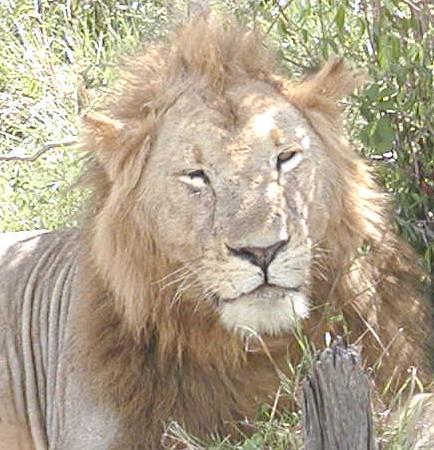 � 2004 by Elaine Radford, all rights reserved
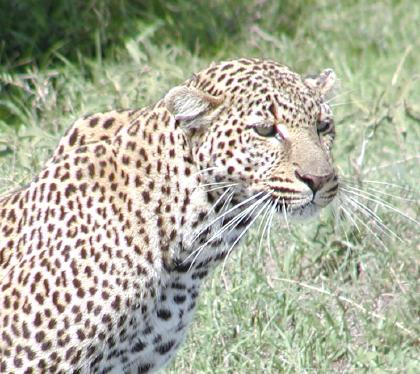 � 2004 by Elaine Radford, all rights reserved
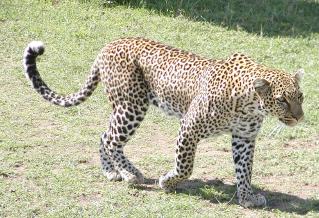 � 2004 by Elaine Radford, all rights reserved People take safaris for many years without ever witnessing a Leopard make a successful kill; indeed, for all his years in Africa, I'm pretty sure that Bill said it was the first time he'd witnessed it himself. We just got incredibly lucky. Jan. 24, 2004 OK, so you know it's a rich area when, on the last day heading home, you are not only still finding new birds, but you are finding new categories of birds. Here's a list of just the new life birds I added today, including one from the new category of coursers and pratincoles:
It would be tough to pick a favorite from all these well-seen, almost-posing birds, but I have to say that I was particularly impressed by the sparkling beauty of the Violet-backed Starling.
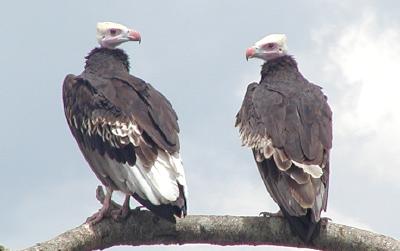 � 2004 by Elaine Radford, all rights reserved
 � 2004 by Elaine Radford, all rights reserved And I can't forget to mention the fine Martial Eagle that we saw perched alongside the road. As A. commented, "You always see a Martial Eagle on the last day!" I'm not sure if that's actually the law of the land or anything, but it was certainly a fine view of a magnificent bird -- and a fine farewell to what is surely one of the most magnificent birding and wildlife areas remaining in the world. You have just read Part Four of my Kenya Diary. To find out what happened next, go here. To find out how it all started, go back and read Part One , Part Two, and Part Three. Go here for my bird list complete with pictures or go here for my animal checklist.

All Rights Reserved, Copyright 2002-2017 by Elaine Radford
|
